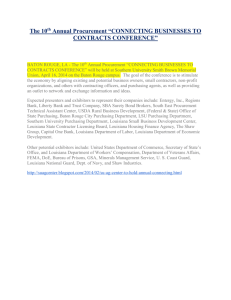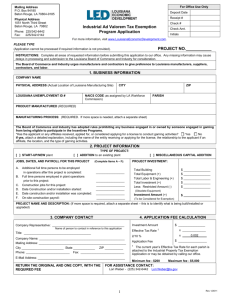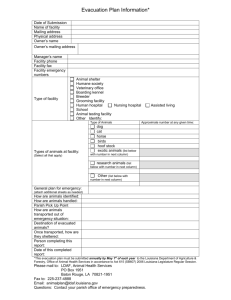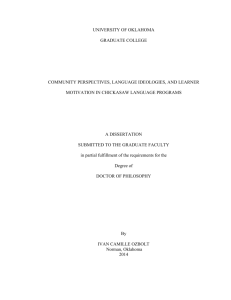Anyone who has searched for 19th Century Louisiana birth records
advertisement
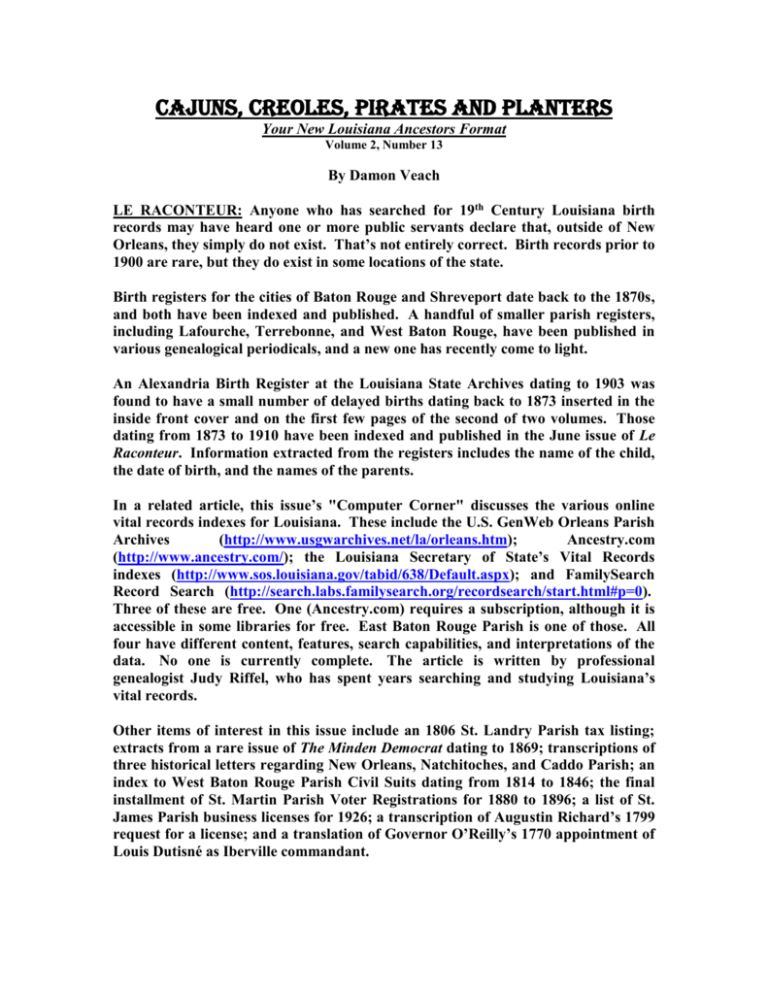
CAJUNS, CREOLES, PIRATES AND PLANTERS Your New Louisiana Ancestors Format Volume 2, Number 13 By Damon Veach LE RACONTEUR: Anyone who has searched for 19th Century Louisiana birth records may have heard one or more public servants declare that, outside of New Orleans, they simply do not exist. That’s not entirely correct. Birth records prior to 1900 are rare, but they do exist in some locations of the state. Birth registers for the cities of Baton Rouge and Shreveport date back to the 1870s, and both have been indexed and published. A handful of smaller parish registers, including Lafourche, Terrebonne, and West Baton Rouge, have been published in various genealogical periodicals, and a new one has recently come to light. An Alexandria Birth Register at the Louisiana State Archives dating to 1903 was found to have a small number of delayed births dating back to 1873 inserted in the inside front cover and on the first few pages of the second of two volumes. Those dating from 1873 to 1910 have been indexed and published in the June issue of Le Raconteur. Information extracted from the registers includes the name of the child, the date of birth, and the names of the parents. In a related article, this issue’s "Computer Corner" discusses the various online vital records indexes for Louisiana. These include the U.S. GenWeb Orleans Parish Archives (http://www.usgwarchives.net/la/orleans.htm); Ancestry.com (http://www.ancestry.com/); the Louisiana Secretary of State’s Vital Records indexes (http://www.sos.louisiana.gov/tabid/638/Default.aspx); and FamilySearch Record Search (http://search.labs.familysearch.org/recordsearch/start.html#p=0). Three of these are free. One (Ancestry.com) requires a subscription, although it is accessible in some libraries for free. East Baton Rouge Parish is one of those. All four have different content, features, search capabilities, and interpretations of the data. No one is currently complete. The article is written by professional genealogist Judy Riffel, who has spent years searching and studying Louisiana’s vital records. Other items of interest in this issue include an 1806 St. Landry Parish tax listing; extracts from a rare issue of The Minden Democrat dating to 1869; transcriptions of three historical letters regarding New Orleans, Natchitoches, and Caddo Parish; an index to West Baton Rouge Parish Civil Suits dating from 1814 to 1846; the final installment of St. Martin Parish Voter Registrations for 1880 to 1896; a list of St. James Parish business licenses for 1926; a transcription of Augustin Richard’s 1799 request for a license; and a translation of Governor O’Reilly’s 1770 appointment of Louis Dutisné as Iberville commandant. The June issue of Le Raconteur comes with a 2010 membership in Le Comité des Archives de la Louisiane. Dues are $20 and may be mailed to P.O. Box 1547, Baton Rouge, LA 70821. A membership form can be downloaded at the society’s website (www.lecomite.org). XXX ANNUAL MEETING: Le Comité des Archives de la Louisiane has scheduled its annual meeting for Sunday, September 26, 2010 at 1 p.m. at the Embassy Suites in Baton Rouge. This is a new location for their annual meeting. Barry Ancelet of the University of Louisiana Lafayette, author of Dictionary of Louisiana French: As Spoken in Cajun, Creole, and Native American Communities, will speak on this new book. Judy Riffel will also give a presentation on Louisiana Spanish Land Grants. XXX BULLER GATHERING: The Buller 25th Biennial will be held September 25, 2010 in Lafayette at the Vermillionville, a folk life park which contains the Buller House, ca1807. Lunch and entry fee for adults is $20, children under 10, $10. For further information, contact Brenda Fuselier, 208 Louie Dr., Lafayette, LA 70503. Her email address is bbf@lusfiber.net, or call 337-233-9908. XXX INDIAN RECORDS: Chickasaw by Blood is a series of Native American source records compiled by genealogist Jeff Bowen. The multi-volume undertaking is based on the Chickasaw enrollment cards, sometimes called "census cards," prepared by the Commission to the Five Civilized Tribes (the Dawes Commission) between 1898 and 1914. The Commission's purpose was to rule on citizenship applications submitted by members of the Five Civilized Tribes covering some 250,000 persons. The Commission ultimately enrolled 101,000 people according to the following categories: Citizens by Blood, Citizens by Marriage, New Born Citizens by Blood, Minor Citizens by Blood, Freedmen (former black slaves of Indians), New Born Freedmen, and Minor Freedmen, indicating its findings on the enrollment cards. For this series, Bowen has transcribed the genealogical contents of the cards from National Archives Microfilm Series M-1186: Roll 67, pp. 1-662; and Roll 68, pp. 663-1424. This transcription of the Chickasaw enrollment cards provides the following information on each individual whose name appeared in a given application: county of residence, post office (local address), name, relationship to first person named in application, age, sex, Blood Tribal Enrollment (year, town, page), and similar identifying information for the parents of the first person named. In addition to the foregoing standard information, which Bowen has arranged in a tabular format, researchers will discover valuable data in the "Notes" section at the conclusion of each card’s contents. Besides the Dawes Roll No., the Notes contain other name listings, references to different cards, birth dates, death dates, listings on various payrolls with years, mention of a spouse in the "doubtful" category or from another tribe, and more. In all, Volume III of Chickasaw by Blood names 3,200 persons seeking citizenship status at this crucial time in Native American history, bringing the total number of persons acknowledged to be "Chickasaw by blood" to over 10,000. This is another excellent volume from the Clearfield Company, 3600 Clipper Mill Road, Suite 260, Baltimore, MD 21211. The price is $29.50, plus $5.50 shipping and handling. See also Volume I, Volume II, and Volume IV of this series. XXX DE VILLE BOOKS: Louisiana colonists expelled the first Spanish governor of their province in 1768. That Louisiana colonials dared to antagonize Spain further, when they issued a Manifesto the following year, has generated many debates. Some early historians were convinced that the well-wrought document was America’s first Declaration of Independence. Few modern-day scholars have given enough attention to the manifesto itself, its elegant language, political precepts, and its incisive conclusions. This un-annotated publication presents the primary source for further study. The Louisiana Manifesto of 1769 contains only 28 pages, but it is one of the more important early documents in Louisiana history. The price is $18.50. The introduction was written by Winston De Ville. Order Now! Another publication that was previously published by Provincial Press and now published by Claitor’s Publishing is The Pascagoula Indians by Jay Higgingbotham. The Pascagoula Indians were one of several small bands of Native Americans living on the northern Gulf of Mexico coast when the area was first explored by the French and Spanish in the sixteenth century. They were significant to the history of the Deep South because of the aid they gave to the colonization of the province of Louisiana because of the name they bequeathed to the river, bay and city of Pascagoula, Mississippi. This was all because they were among the earliest known inhabitants of the area and because of the many legends they inspired. Most of what is known about the Pascagoula natives was recorded by early French chroniclers. Those observations have been preserved in numerous archives in Canada, France, and the United States. In the 1960s, Higginbotham searched these archives extensively in addition to those in Spain and Mexico. This volume sells for $26.

